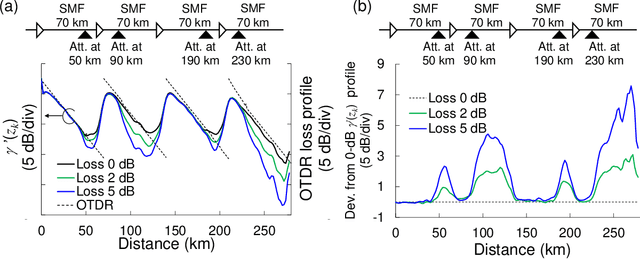Shuto Yamamoto
Iterative Decoder of Channel-polarized Multilevel Coding for Data Center Networks
Mar 26, 2025Abstract:Data center networks (DCNs) require a low-cost, low-power optical transceiver to handle increased traffic from generative artificial intelligence, video streaming services, and more. Improving the required signal-to-noise ratio (RSNR) by digital signal processing such as forward error correction (FEC) mitigates the requirements for electrical and optical components. The optical transceivers in DCNs exploit a low-complexity soft-decision (SD) FEC, consisting of short block-length linear error-correcting codes and a low-complexity SD decoder (SDD), such as a Chase decoder and ordered statistical decoding. The low complexity SDD efficiently approaches a maximum likelihood decoding (MLD). However, the decoding performance of MLD is limited by its finite block length. In this paper, we describe the detail of our proposed channel-polarized multilevel coding with iterative decoding (CP-MLC-ID), which improves the decoding performance. The 19.5$\%$-OH CP-MLC-ID 128-bit extended Bose-Chaudhuri-Hocquenghem (eBCH) and KP4 codes outperform the concatenated eBCH and KP4 codes with a net coding gain of 0.25 and 0.40 dB for the same and double the number of SDDs, respectively. We also investigate the dependency of the decoding performance on the size of a bit interleaver. The performance degradation of CP-MLC-ID using an 8-bit interleaver is about 0.1 dB compared to using the large-bit interleaver. Our results indicate that even a weak connection by exclusive-OR between codewords improves the decoding performance, compared to simple concatenated codes in the DCNs.
First demonstration of C + L band CDCROADM with simple node configuration using multiband switching devices
Jun 04, 2021



Abstract:While ultrahigh-baud-rate optical signals are effective for extending the transmission distance of large capacity signals, they also reduce the number of wavelengths that can be arranged in a band because of their wider bandwidth. This reduces the flexibility of optical path configuration in reconfigurable optical add/drop multiplexing (ROADM) networks. In colorless, directionless and contentionless (CDC)-ROADM in particular, the effect reduces the add/drop ratio at a node. Multiband ROADM systems are an effective countermeasure for overcoming this issue, but they make the node configuration more complicated and its operation more difficult. In this paper, we analyze the challenges of C + L band CDC-ROADM and show that optical switch devices that operate over multiple bands are effective in meeting them. For this purpose, we built a C + L band CDC-ROADM node based on C + L band wavelength selective switches (WSSs) and multicast switches (MCSs) and confirmed its effectiveness experimentally. In particular, to simplify the node configuration, we propose a reduction in the number of optical amplifiers used for node loss compensation and experimentally verify its feasibility.
Physics-oriented learning of nonlinear Schrödinger equation: optical fiber loss and dispersion profile identification
Apr 13, 2021



Abstract:In optical fiber communication, system identification (SI) for the nonlinear Schr\"odinger equation (NLSE) has long been studied mainly for fiber nonlinearity compensation (NLC). One recent line of inquiry to combine a behavioral-model approach like digital backpropagation (DBP) and a data-driven approach like neural network (NN). These works are aimed for more NLC gain; however, by directing our attention to the learned parameters in such a SI process, system status information, i.e., optical fiber parameters, will possibly be extracted. Here, we show that the model-based optimization and interpretable nature of the learned parameters in NN-based DBP enable transmission line monitoring, fully extracting the actual in-line NLSE parameter distributions. Specifically, we demonstrate that longitudinal loss and dispersion profiles along a multi-span link can be obtained at once, directly from data-carrying signals without any dedicated analog devices such as optical time-domain reflectometry. We apply the method to a long-haul (~2,080 km) link and various link conditions are tested, including excess loss inserted, different fiber input power, and non-uniform level diagram. The measurement performance is also investigated in terms of measurement range, accuracy, and fiber launch power. These results provide a path toward simplified and automated network management as another application of DBP.
 Add to Chrome
Add to Chrome Add to Firefox
Add to Firefox Add to Edge
Add to Edge